When planning an art workshop for kids, it’s essential to select materials that prioritize safety, creativity, and engagement. Opt for non-toxic supplies that are easy to use and clean up, ensuring a fun and secure environment for young artists to express themselves. By choosing certified products, you can foster a safe and inspiring creative experience for all participants.
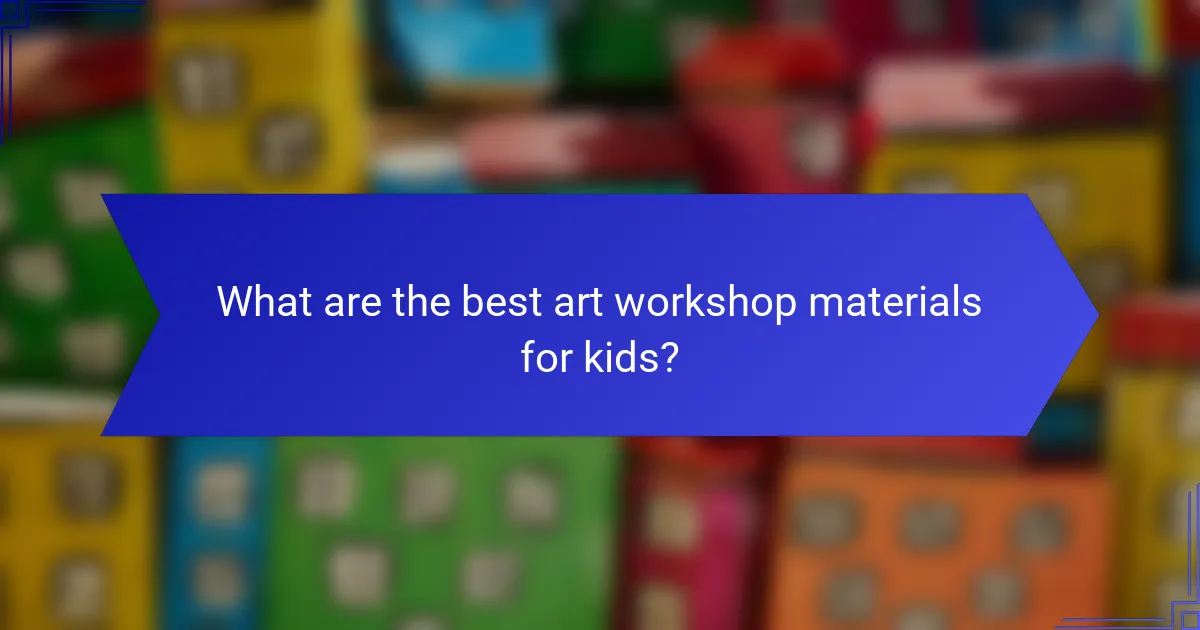
What are the best art workshop materials for kids?
The best art workshop materials for kids prioritize safety, creativity, and engagement. Non-toxic options that are easy to use and clean up will enhance the artistic experience while ensuring a safe environment for young artists.
Non-toxic paints
Non-toxic paints are essential for children’s art projects, as they minimize health risks. Look for paints labeled as AP (Approved Product) non-toxic, which indicates they meet safety standards for children’s use.
Water-based acrylics and tempera paints are popular choices due to their vibrant colors and easy cleanup. Always supervise children while painting to prevent ingestion or misuse.
Child-safe scissors
Child-safe scissors are designed with rounded tips and a blunt edge to prevent injuries. These scissors allow kids to practice cutting without the risk associated with traditional scissors.
When selecting scissors, consider the age and skill level of the child. For younger kids, look for scissors that require minimal pressure to cut, while older children can handle more advanced options.
Washable markers
Washable markers are ideal for kids as they easily clean off skin and surfaces. Choose markers that are labeled as washable to avoid permanent stains on clothes and furniture.
Consider sets that include a variety of colors and tip sizes, allowing for diverse artistic expression. Always check for non-toxic labels to ensure safety during use.
Recyclable paper
Recyclable paper is a sustainable choice for art projects, allowing kids to create while being environmentally conscious. Look for paper made from recycled materials or products that can be recycled after use.
Different types of paper, such as construction paper, watercolor paper, and drawing pads, can cater to various artistic techniques. Encourage kids to use both sides of the paper to minimize waste.
Clay and modeling dough
Clay and modeling dough provide tactile experiences that enhance creativity. Opt for non-toxic, air-dry clay or soft modeling dough that is safe for children to handle.
These materials can be used for sculpting, molding, and creating three-dimensional art. Ensure that children wash their hands after use to maintain hygiene, especially if they are working with dough that may contain allergens.
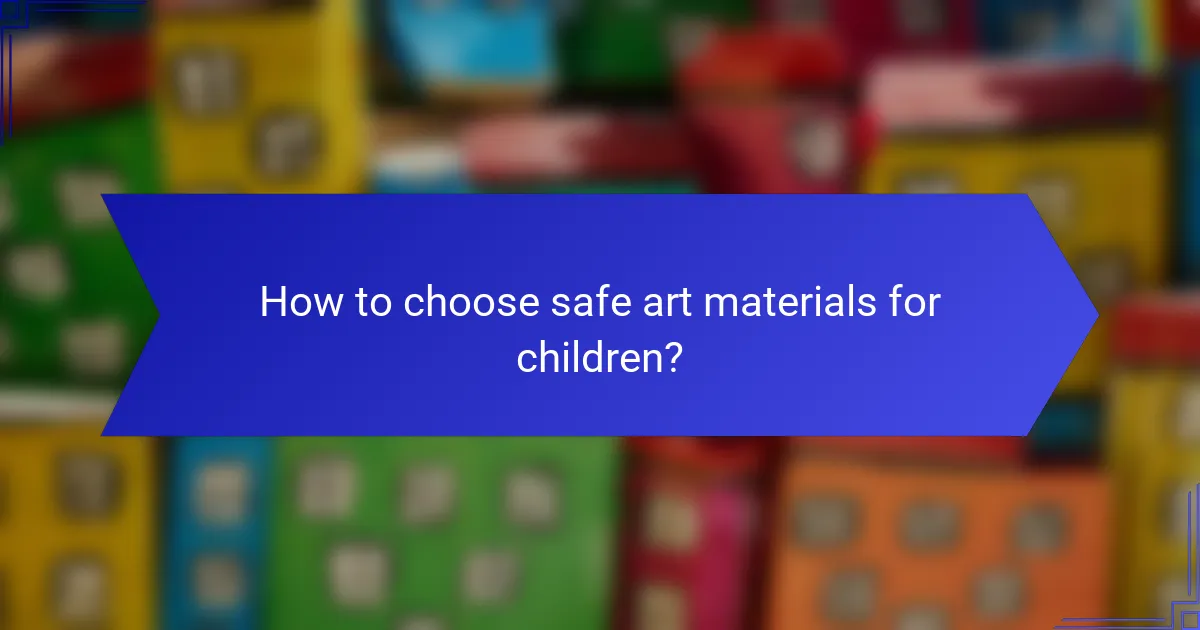
How to choose safe art materials for children?
Choosing safe art materials for children involves selecting products that meet safety standards and are free from harmful substances. Prioritize items that are certified and labeled as non-toxic to ensure a fun and secure creative environment.
Look for ASTM certification
ASTM certification indicates that art materials have been tested for safety and meet specific standards set by the American Society for Testing and Materials. This certification helps parents and educators identify products that are less likely to pose health risks to children.
When shopping, look for the ASTM D4236 label, which signifies that the product has been evaluated for potential hazards. This label is commonly found on paints, markers, and other art supplies.
Check for non-toxic labels
Non-toxic labels are crucial in ensuring that art materials are safe for children to use. Products labeled as non-toxic have undergone testing to confirm they do not contain harmful chemicals that could pose health risks.
Common non-toxic certifications include AP (Approved Product) and CP (Certified Product) from the Art and Creative Materials Institute. Always check for these labels when selecting items like crayons, glues, and paints.
Consider age-appropriate options
Age-appropriate art materials are designed with children’s developmental stages in mind, ensuring safety and usability. For younger children, opt for larger, easier-to-handle items such as chunky crayons or washable paints.
As children grow, they can handle more complex materials, such as fine-tipped markers or modeling clay. Always review the manufacturer’s age recommendations to avoid products that may pose choking hazards or be too advanced for their skill level.
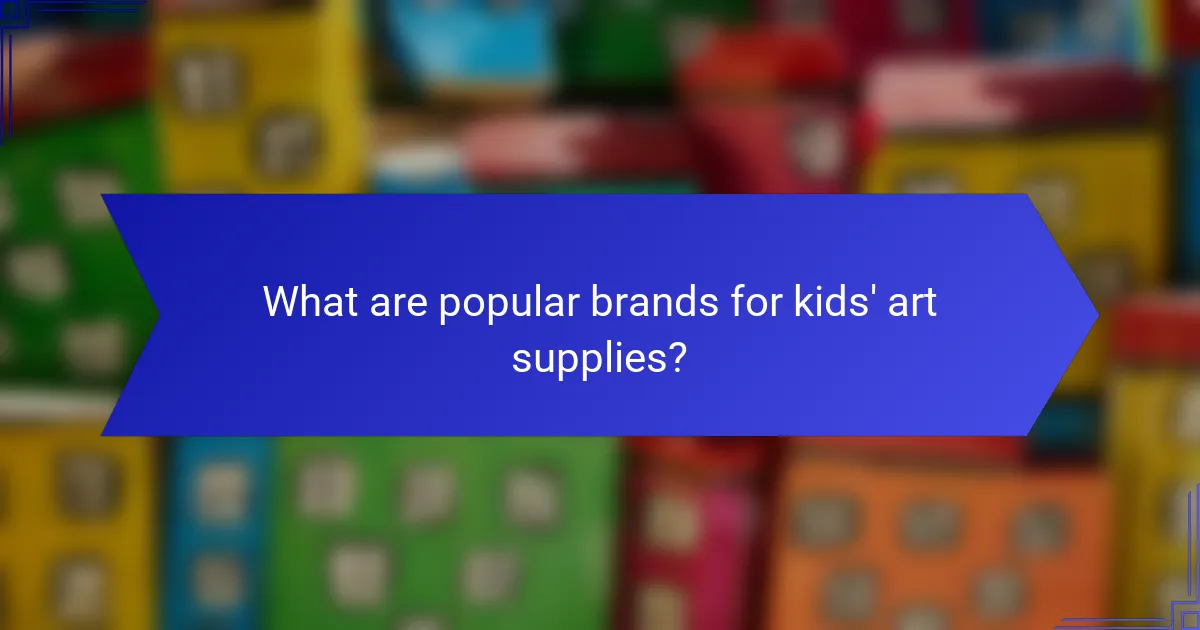
What are popular brands for kids’ art supplies?
Popular brands for kids’ art supplies focus on safety, creativity, and engagement. These brands are known for producing high-quality materials that are non-toxic and designed specifically for young artists.
Crayola
Crayola is a leading brand in children’s art supplies, renowned for its vibrant crayons, markers, and colored pencils. Their products are non-toxic and designed to be easy for small hands to use, making them ideal for kids of all ages.
When selecting Crayola products, consider their washable options, which are perfect for minimizing mess during art projects. Crayola also offers a variety of themed sets that can inspire creativity and provide a fun experience for children.
Faber-Castell
Faber-Castell is another trusted name in art supplies, known for its high-quality colored pencils and watercolor products. Their art materials are often favored by educators for their durability and ease of use.
Look for Faber-Castell’s beginner sets, which include a range of colors and tools tailored for young artists. Their products are designed with ergonomic features, making them comfortable for kids to hold while they create.
Melissa & Doug
Melissa & Doug offers a variety of creative art supplies that encourage imaginative play. Their products include craft kits, painting sets, and drawing tools that are safe for children and promote hands-on learning.
When choosing Melissa & Doug art supplies, consider their themed craft kits, which often come with all necessary materials and instructions. These kits can provide structured activities that help develop fine motor skills and artistic expression.

How can parents ensure a fun art experience?
Parents can ensure a fun art experience by selecting safe materials and engaging activities that spark children’s creativity. Planning themed projects and using interactive techniques can enhance enjoyment and learning.
Incorporate themed projects
Themed projects provide a focused framework that can make art activities more engaging for kids. Consider themes like nature, animals, or holidays, which can inspire creativity and make the process more relatable.
For example, a nature theme could involve collecting leaves and using them for printmaking, while a holiday theme might include creating decorations or cards. This approach not only makes art fun but also helps children learn about different subjects.
Use interactive techniques
Interactive techniques encourage participation and keep children engaged during art activities. Techniques such as collaborative murals or group projects can foster teamwork and communication among kids.
Incorporating technology, like using tablets for digital drawing or augmented reality apps, can also enhance interaction. These methods can make the art experience more dynamic and appealing to tech-savvy children.
Encourage creativity and expression
Encouraging creativity and self-expression is vital for a fulfilling art experience. Allow children to choose their colors, materials, and techniques, which helps them feel more invested in their work.
Provide open-ended prompts instead of strict guidelines. For instance, instead of asking them to draw a specific object, suggest they create something inspired by their favorite story. This freedom can lead to unique creations and boost their confidence in their artistic abilities.
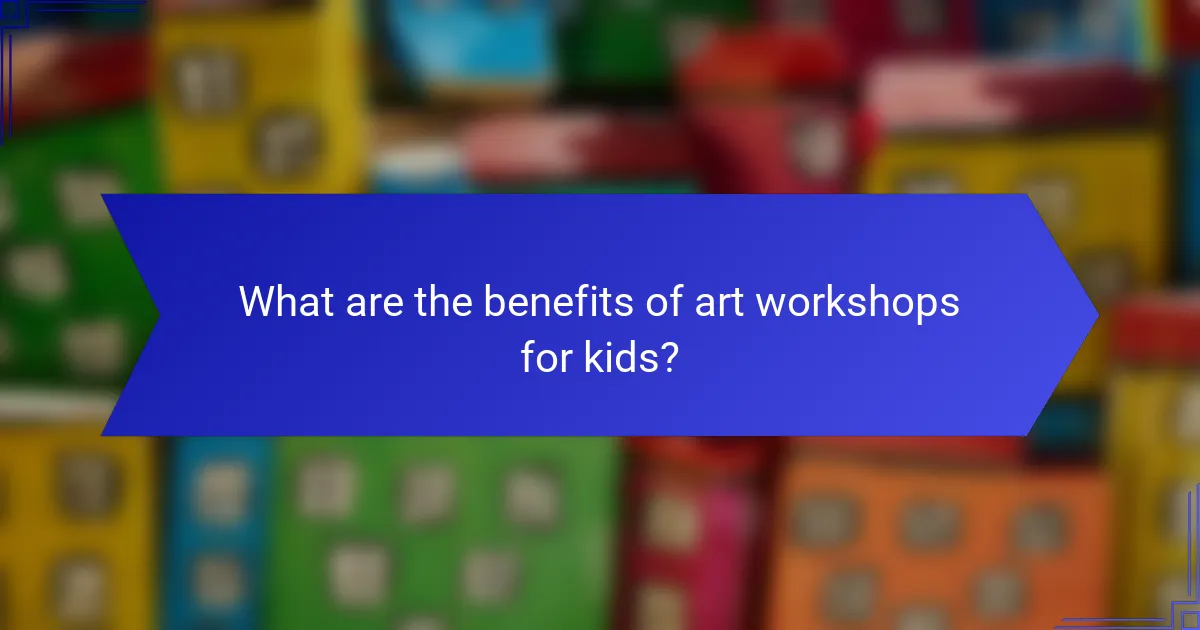
What are the benefits of art workshops for kids?
Art workshops for kids provide numerous benefits, including the development of essential skills and fostering a love for creativity. These workshops create an engaging environment where children can explore their artistic abilities while enhancing their cognitive and social skills.
Enhances fine motor skills
Participating in art workshops helps children improve their fine motor skills through activities like painting, drawing, and sculpting. These tasks require precise hand movements, which can enhance coordination and dexterity. For instance, using brushes or scissors can significantly develop grip strength and control.
To maximize these benefits, consider providing a variety of materials, such as different brush sizes and textured papers. This variety encourages children to practice and refine their skills in a fun and engaging way.
Boosts creativity and imagination
Art workshops stimulate children’s creativity and imagination by allowing them to express themselves freely. When kids engage in artistic activities, they learn to think outside the box and explore new ideas. This creative process can lead to innovative problem-solving skills that are valuable in other areas of life.
Encourage children to experiment with colors, shapes, and techniques without the fear of making mistakes. Providing open-ended projects can further enhance their imaginative thinking and lead to unique artistic expressions.
Promotes social interaction
Art workshops create a collaborative environment where children can interact with their peers. Working together on projects fosters teamwork, communication, and sharing of ideas. These social interactions are crucial for developing interpersonal skills and building friendships.
To facilitate social engagement, consider organizing group projects or art challenges. This not only encourages cooperation but also allows children to learn from one another, enhancing their overall experience in the workshop.
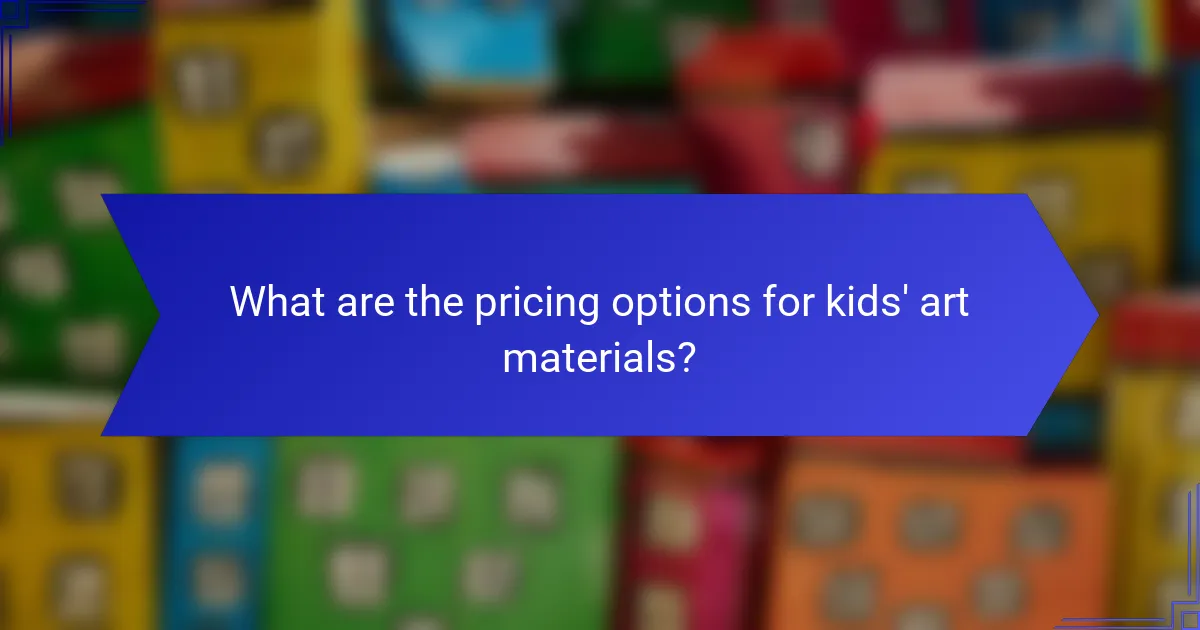
What are the pricing options for kids’ art materials?
Pricing for kids’ art materials can vary significantly based on quality, brand, and type of supplies. Generally, you can find options ranging from budget-friendly kits to premium selections, allowing parents to choose based on their budget and the intended use.
Budget-friendly kits
Budget-friendly art kits are an excellent option for parents looking to provide creative materials without overspending. These kits often include a variety of supplies such as crayons, markers, colored pencils, and basic paper, typically priced between $10 to $30.
When selecting a budget-friendly kit, consider the age of your child and the types of projects they enjoy. Some kits are designed specifically for younger children, featuring non-toxic materials and easy-to-use tools, while others may cater to older kids with more advanced supplies.
To ensure you get the best value, compare the number of items included in each kit and look for sales or discounts at local stores or online retailers. It’s also wise to read reviews to gauge the quality of the materials before making a purchase.
